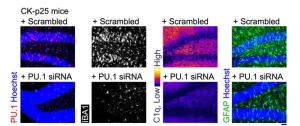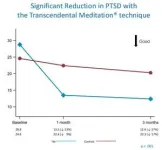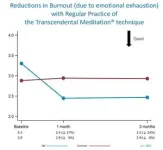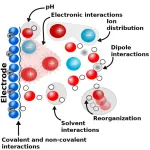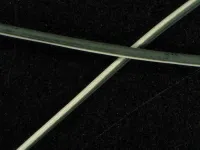(Press-News.org) Some Covid-19 vaccines safely and effectively used lipid nanoparticles (LNPs) to deliver messenger RNA to cells. A new MIT study shows that different nanoparticles could be used for a potential Alzheimer’s disease (AD) therapy. In tests in multiple mouse models and with cultured human cells, a newly tailored LNP formulation effectively delivered small interfering RNA (siRNA) to the brain’s microglia immune cells to suppress expression of a protein linked to excessive inflammation in Alzheimer’s disease.
In a prior study the researchers showed that blocking the consequences of PU.1 protein activity helps to reduce Alzheimer’s disease-related neuroinflammation and pathology. The new results, reported in the journal Advanced Materials (impact factor 29.4 ) achieves a reduction in inflammation by directly tamping down expression of the Spi1 gene that encodes PU.1. More generally, the new study also demonstrates a new way to deliver RNA to microglia, which have been difficult to target so far.
Study co-senior author Li-Huei Tsai, Picower Professor of Neuroscience and Director of The Picower Institute for Learning and Memory and Aging Brain Initiative, said she hypothesized that LNPs might work as a way to bring siRNA into microglia because the cells, which clear waste in the brain, have a strong proclivity to uptake lipid molecules. She discussed this with Robert Langer, David Koch Institute Professor, who widely known for his seminal work on nanoparticle drug delivery, They decided to test the idea of reducing PU.1 expression with an LNP-delivered siRNA.
“I still remember the day when I asked to meet with Bob to discuss the idea of testing LNPs as a payload to target inflammatory microglia,” said Tsai, a faculty member in the Department of Brain and Cognitive Sciences. “I am very grateful to The JPB Foundation who supported this idea without any preliminary evidence.”
Langer Lab graduate student Jason Andresen and former Tsai Lab postdoc William Ralvenius led the work and are the study’s co-lead authors. Owen Fenton, a former Langer Lab postdoc who is now an assistant professor at the University of North Carolina’s Eshelman School of Pharmacy, is a co-corresponding author along with Tsai and Langer. Langer is a Professor in Chemical Engineering, Biological Engineering and the Koch Institute for Integrative Cancer Research.
Perfecting a particle
The simplest way to test whether siRNA could therapeutically suppress PU.1 expression would have been to make use of an already available delivery device, but one of the first discoveries in the study is that none of eight commercially available reagents could safely and effectively transfect cultured human microglia-like cells in the lab.
Instead the team had to optimize an LNP to do the job. LNPs have four main components and by changing the structures of two of them, and by varying the ratio of lipids to RNA, the researchers were able to come up with seven formulations to try. Importantly, their testing included trying their formulations on cultured microglia that they had induced into an inflammatory state. That state, after all, is the one in which the proposed treatment is needed.
Among the seven candidates, one the team named “MG-LNP” stood out for its especially high delivery efficiency and safety of a test RNA cargo.
What works in a dish sometimes doesn’t work in a living organism, so the team next tested their LNP formulations’ effectiveness and safety in mice. Testing two different methods of injection, into the body or into the cerebrospinal fluid (CSF), they found that injection into the CSF ensured much greater efficacy in targeting microglia without affecting cells in other organs. Among the seven formulations, MG-LNP again proved the most effective at transfecting microglia. Langer said he believes this could potentially open new ways of treating certain brain diseases with nanoparticles someday.
A targeted therapy
Once they knew MG-LNP could deliver a test cargo to microglia both in human cell cultures and mice, the scientists then tested whether using it to deliver a PU.1-suppressing siRNA could reduce inflammation in microglia. In the cell cultures, a relatively low dose achieved a 42 percent reduction of PU.1 expression (which is good because microglia need at least some PU.1 to live). Indeed MG-LNP transfection did not cause the cells any harm. It also significantly reduced the transcription of the genes that PU.1 expression increases in microglia, indicating that it can reduce multiple inflammatory markers.
In all these measures, and others, MG-LNP outperformed a commercially available reagent called RNAiMAX that the scientists tested in parallel.
“These findings support the use of MG-LNP-mediated anti-PU.1 siRNA delivery as a potential therapy for neuroinflammatory diseases,” the researchers wrote.
The final set of tests evaluated MG-LNP’s performance delivering the siRNA in two mouse models of inflammation in the brain. In one, mice were exposed to LPS, a molecule that simulates infection and stimulates a systemic inflammation response. In the other model, mice exhibit severe neurodegeneration and inflammation when an enzyme called CDK5 becomes hyperactivated by a protein called p25.
In both models, injection of MG-LNPs carrying the anti-PU.1 siRNA reduced expression of PU.1 and inflammatory markers, much like in the cultured human cells.
“MG-LNP delivery of anti-PU.1 siRNA can potentially be used as an anti-inflammatory therapeutic in mice with systemic inflammation an in the CK-p25 mouse model of AD-like neuroinflammation,” the scientists concluded, calling the results a “proof-of-principle.” More testing will be required before the idea could be tried in human patients.
In addition to Andresen, Ralvenius, Langer, Tsai and Owen, the paper’s other authors are Margaret Huston, Jay Penney and Julia Maeve Bonner.
In addition to the The JPB Foundation and The Picower Institute for Learning and Memory, the Robert and Renee Belfer Family, Eduardo Eurnekian, Lester A. Gimpelson, Jay L. and Carroll Miller, the Koch Institute, the Swiss National Science Foundation and the Alzheimer’s Association provided funding for the study.
END
Nanoparticle-delivered RNA reduces neuroinflammation in lab tests
In mice and human cell cultures, MIT researchers showed that novel nanoparticles can deliver a potential therapy for inflammation in the brain, a prominent symptom in Alzheimer’s disease
2023-12-11
ELSE PRESS RELEASES FROM THIS DATE:
New insight on electrochemical reactions – advancing the green transition
2023-12-11
Electrochemical reactions are central to the green transitions. These reactions use the electric current and potential difference to carry out chemical reactions, which enables binding and realizing electric energy from chemical bonds. This chemistry is the basis for several applications, such as hydrogen technology, batteries, and various aspects of circular economy.
Developments and improvement in these technologies require detailed insight into the electrochemical reactions and different factors impacting them. Recent studies have shown that besides the electrode material also the used solvent, its acidity, and ...
New conductive, cotton-based fiber developed for smart textiles
2023-12-11
PULLMAN, Wash. – A single strand of fiber developed at Washington State University has the flexibility of cotton and the electric conductivity of a polymer, called polyaniline.
The newly developed material showed good potential for wearable e-textiles. The WSU researchers tested the fibers with a system that powered an LED light and another that sensed ammonia gas, detailing their findings in the journal Carbohydrate Polymers.
“We have one fiber in two sections: one section is the conventional cotton: flexible and strong enough for everyday use, and the other side is the conductive material,” said Hang Liu, WSU textile ...
New therapeutic target for rare type of childhood epilepsy
2023-12-11
Researchers at the Francis Crick Institute, UCL and MSD have identified a potential treatment target for a genetic type of epilepsy.
Developmental and epileptic encephalopathies are rare types of epilepsy which start in early childhood. One of the most common types of genetic epilepsy, CDKL5 deficiency disorder (CDD), causes seizures and impaired development. Children are currently treated with generic antiepileptic drugs, as there aren’t yet any disease-targeting medications for this disorder.
CDD involves losing the function of a gene producing the CDKL5 enzyme, which phosphorylates proteins, meaning it adds an extra phosphate ...
Advanced MRI technology detects changes in the brain after COVID-19
2023-12-11
Researchers at Linköping University, Sweden, have examined the brains of 16 patients previously hospitalised for COVID-19 with persisting symptoms. They have found differences in brain tissue structure between patients with persisting symptoms after COVID-19 and healthy people. Their findings, published in the journal Brain Communications, can bring insights into the underlying mechanisms of persisting neurological problems after COVID-19.
Several previous studies of persisting problems after COVID have involved MRI brain scanning. Although researchers have found differences compared with healthy brains, these differences are not specific ...
New study reveals latest data on global burden of cardiovascular disease
2023-12-11
A world without cardiovascular disease (CVD) is possible, yet millions of lives are lost prematurely to heart disease each year, according to the new Global Burden of Disease (GBD) special report published today in the Journal of the American College of Cardiology. The report provides an update of health estimates for the global, regional and national burden and trends of CVD from 1990-2022 by analyzing the impact of cardiovascular conditions and risk factors across 21 global regions.
Research from this study reflects an urgent need ...
Rail industry urged to consider safety risks of space weather
2023-12-11
Train accidents could be caused by solar storms switching signalling from red to green according to new research examining the impact of space weather.
Solar storms can trigger powerful magnetic disturbances on Earth, creating geomagnetically induced currents (GICs) which could potentially interfere with electricity transmission and distribution grids.
A team led by PhD researcher Cameron Patterson and Professor Jim Wild from Lancaster University modelled how GICs flowed through the track circuits of AC electrified lines powered with overhead cables.
Using two routes - the Preston to Lancaster section of the West ...
Technology not growing fast enough to decarbonize steel and cement industries by 2050
2023-12-11
Steel and cement are two materials that no society can do without. Their production comes with a significant carbon footprint, however. To meet zero-emission targets under the Paris Agreement, countries, cities, and industries are depending on new large-scale infrastructure for CO2 transport and storage, renewable electricity and green hydrogen. A new study by researchers at the National Institute for Environmental Studies, Japan, and the University of Cambridge, United Kingdom, shows that the current rate of deployment of this infrastructure is insufficient. The study ...
Landscape for AML patients evolving rapidly as research discoveries advance new treatments
2023-12-11
MIAMI, FLORIDA (EMBARGOED UNTIL DEC. 10, 2023, AT 7:30 P.M. ET) – The treatment landscape for acute myeloid leukemia (AML) is evolving rapidly, as research discoveries at Sylvester Comprehensive Cancer Center at the University of Miami Miller School of Medicine and other academic cancer centers advance new, more effective therapies for this aggressive blood cancer.
“We’ve seen more progress during the past 10 years than the previous four decades combined,” said Justin M. Watts, M.D., Sylvester hematologist, associate professor of medicine, and Pap Corps Early Career ...
'Exceptional' results in phase III leukaemia trial
2023-12-11
University of Leeds news
Embargo: 19:30 ET on Sunday 10 December 2023 / 00.30 GMT on Monday 11 December 2023
New personalised therapy improves survival for patients with CLL leukaemia
Personalised treatment for the most common form of adult leukaemia helps patients survive for longer and stay in remission, a phase III trial has found.
The trial, by the University of Leeds, has been identified as groundbreaking research by the New England Journal of Medicine and the 65th American Society of Hematology (ASH) Annual Meeting and Exposition in San Diego, where ...
Cell therapy appears safe and effective for lymphoma in remission
2023-12-11
DOWNLOADABLE VIDEO HERE
MIAMI, FLORIDA (EMBARGOED UNTIL SUNDAY, DEC. 10, 2023 AT 8:00 P.M. ET) – A study led by researchers at Sylvester Comprehensive Cancer Center at the University of Miami Miller School of Medicine suggests that CAR-T immunotherapy remains a viable option for patients who have lymphoma that goes into remission before the cell therapy begins.
While the study doesn’t answer the question of whether cell therapy in remission is the right choice, it does say that it’s not the wrong choice.
“I ...
LAST 30 PRESS RELEASES:
Tracing the quick synthesis of an industrially important catalyst
New software sheds light on cancer’s hidden genetic networks
UT Health San Antonio awarded $3 million in CPRIT grants to bolster cancer research and prevention efforts in South Texas
Third symposium spotlights global challenge of new contaminants in China’s fight against pollution
From straw to soil harmony: International team reveals how biochar supercharges carbon-smart farming
Myeloma: How AI is redrawing the map of cancer care
Manhattan E. Charurat, Ph.D., MHS invested as the Homer and Martha Gudelsky Distinguished Professor in Medicine at the University of Maryland School of Medicine
Insilico Medicine’s Pharma.AI Q4 Winter Launch Recap: Revolutionizing drug discovery with cutting-edge AI innovations, accelerating the path to pharmaceutical superintelligence
Nanoplastics have diet-dependent impacts on digestive system health
Brain neuron death occurs throughout life and increases with age, a natural human protein drug may halt neuron death in Alzheimer’s disease
SPIE and CLP announce the recipients of the 2025 Advanced Photonics Young Innovator Award
Lessons from the Caldor Fire’s Christmas Valley ‘Miracle’
Ant societies rose by trading individual protection for collective power
Research reveals how ancient viral DNA shapes early embryonic development
A molecular gatekeeper that controls protein synthesis
New ‘cloaking device’ concept to shield sensitive tech from magnetic fields
Researchers show impact of mountain building and climate change on alpine biodiversity
Study models the transition from Neanderthals to modern humans in Europe
University of Phoenix College of Doctoral Studies releases white paper on AI-driven skilling to reduce burnout and restore worker autonomy
AIs fail at the game of visual “telephone”
The levers for a sustainable food system
Potential changes in US homelessness by ending federal support for housing first programs
Vulnerability of large language models to prompt injection when providing medical advice
Researchers develop new system for high-energy-density, long-life, multi-electron transfer bromine-based flow batteries
Ending federal support for housing first programs could increase U.S. homelessness by 5% in one year, new JAMA study finds
New research uncovers molecular ‘safety switch’ shielding cancers from immune attack
Bacteria resisting viral infection can still sink carbon to ocean floor
Younger biological age may increase depression risk in older women during COVID-19
Bharat Innovates 2026 National Basecamp Showcases India’s Most Promising Deep-Tech Ventures
Here’s what determines whether your income level rises or falls
[Press-News.org] Nanoparticle-delivered RNA reduces neuroinflammation in lab testsIn mice and human cell cultures, MIT researchers showed that novel nanoparticles can deliver a potential therapy for inflammation in the brain, a prominent symptom in Alzheimer’s disease
